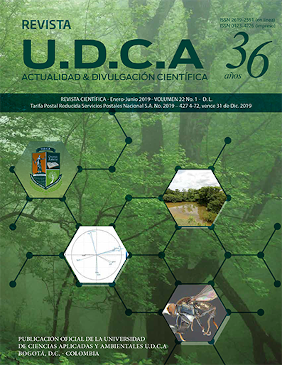Influencia de un recubrimiento comestible adicionado con calcio sobre la calidad de la mora de Castilla
Influence of edible coating added with calcium on andean blackberry quality
Contenido principal del artículo
Resumen
La creciente necesidad de los consumidores por alimentos saludables ha suscitado, en la industria, la búsqueda de tecnologías efectivas, que ofrezcan alimentos seguros y aceptables, sensorialmente, por el consumidor moderno. Los recubrimientos comestibles adicionados con componentes activos aplicados en estructuras vegetales, además de proteger la estructura y conferir mayor conservación, pueden aportar valor nutricional. El objetivo de la investigación fue evaluar la influencia de un recubrimiento comestible a base de alginato de sodio y calcio sobre los atributos de calidad de la mora de Castilla. Se aplicó la metodología de superficie de respuesta, con un diseño central compuesto cara centrado (21 experimentos), considerando las variables independientes: alginato de sodio (2,0-3,0%), cera de abeja (0,5-1,0%), sucroéster (0,15-0,25%), alginato/glicerol (2,0-3,0). La mejor formulación fue: alginato de sodio (2,85%), cera de abeja (1,00%), alginato de sodio/glicerol (2,0) y sucroéste (0,18%), siendo los atributos de calidad de la mora con el recubrimiento comestible: humedad (83,7±1,7%), actividad de agua (0,964±0,010), pH (2,7±0,0), acidez (2,6±0,0%), °Brix (8,1±0,2%), firmeza (12,3±0,7 N), fenoles totales (105,3±4,5mg AG/100g), actividad antioxidante (ABTS: 962,7±15,1mg Trolox/100g y DPPH: 319,3±9,4mg Trolox/100g), luminosidad (22,5±0,7); cromaticidad a* (8,47±0,88); cromaticidad b* (2,12±0,37) y calcio = 144,6±2,7 mg /200g. Los recubrimientos comestibles adicionados con calcio aplicados en la mora de Castilla representan una alternativa efectiva contra los daños mecánicos del fruto y para conservar su calidad, lo cual, podrá mejorar la vida útil durante el almacenamiento.
Palabras clave:
Descargas
Datos de publicación
Perfil evaluadores/as N/D
Declaraciones de autoría
- Sociedad académica
- Universidad de Ciencias Aplicadas UDCA
- Editorial
- Universidad de Ciencias Aplicadas y Ambientales U.D.C.A
Detalles del artículo
Referencias (VER)
ACEVEDO, F.; SOLIVA, R. 2017. Nanoemulsions as edible coatings. Curr. Opin. Food Sci. (Netherlands). 15:43-49. https://doi.org/10.1016/j.cofs.2017.06.002
ALI, A.; MAQBOOL, M.; RAMACHANDRAN, S.; ALDERSON, P. 2012. Gum arabic as a novel edible coating for enhancing shelf-life and improving postharvest quality of tomato (Solanum lycopersicum L.) fruit. Postharvest Biol Technol. (Netherlands). 58:42-47. https://doi.org/10.1016/j.postharvbio.2010.05.005
AOAC. 2012. Official methods of analysis. Association of Official Analytical Chemists. Arlington. 19th edition. Arlington, Virginia (USA). 684p.
ASOCIACIÓN PROVINCIAL DE APICULTORES DE GRANADA-APAG. 2016. Descontaminación industrial de ceras. Valorización de la cera y sus subproductos. Informe final de investigación. (España). p.26. Disponible desde Internet en: http://apinevada.com/media/files/news/Memoriafinal1.pdf (con acceso el 18/01/2018).
CARVALHO, C.; BETANCOUR, A. 2015. Quality characterization of Andean blackberry fruits (Rubus glaucus Benth.) in different maturity stages in Antioquia. Agron Colomb. (Colombia). 33(1):74-83. https://doi.org/10.15446/agron.colomb.v33n1.47132
CHIEN, P.; SHEU, F.; YANG, F. 2007. Effects of edible chitosan coating on quality and shelf life of sliced mango fruit. J. Food. Eng. (England). 78(1):225-229. https://doi.org/10.1016/j.jfoodeng.2005.09.022
FALGUERA, V.; QUINTERO, J.; JIMÉNEZ, A.; MUÑOZ, J.; IBARZ, A. 2011. Edible films and coatings: Structures, active functions and trends in their use. Trends Food Sci Technol. (England). 22(6): 292-303. https://doi.org/10.1016/j.tifs.2011.02.004
FRANCESCHINIS, L.; SALVATORI, D.M.; SOSA, N.; SCHEBOR, C. 2014. Physical and Functional Properties of Blackberry Freeze- and Spray-Dried Powders. Dry Techno. (USA). 32(2):197-207. https://doi.org/10.1080/07373937.2013.814664
GALUS, S.; KADZIŃSKA, J. 2015. Food applications of emulsion-based edible films and coatings. Trends Food Sci. Technol. (England). 45(2):273-283. https://doi.org/10.1016/j.tifs.2015.07.011
GARCÍA, M.; DE LA PAZ, N.; FERNÁNDEZ, M.; VALDÉZ, J. 2014. Evaluación de la actividad antioxidante de disoluciones de sales de quitosana. Ciencia y Tecnología de Alimentos. (Cuba). 24(3):62-66.
GARZÓN, G.; RIEDL, K.; SCHWARTZ, S. 2009. Determination of anthocyanins, total phenolic content, and antioxidant activity in Andes berry (Rubus glaucus Benth). J. Food Sc. (USA). 74(3):227-232. https://doi.org/10.1111/j.1750-3841.2009.01092.x
GHASEMNEZHAD, M.; NEZHAD, M.; SOMAYEH, M. 2010. Changes in Postharvest Quality of Loquat (Eriobotrya japonica) Fruits Influenced by Chitosan. Hort. Environ. Biotechnol. (Korean). 52(1):40-45. https://doi.org/10.1007/s13580-011-0028-5
GRIJALBA, C.; CALDERÓN, L.; PÉREZ, M. 2010. Rendimiento y calidad de la fruta en mora de castilla (Rubus glaucus), con y sin espinas, cultivada en campo abierto en Cajicá (Cundinamarca, Colombia). Rev. Fac. Cienc. Básicas. (Colombia). 6(1):24-41.
HERNÁNDEZ-MUÑOZ, P.; ALMENAR, E.; VALLE, V.D.; VELEZ, D.; GAVARA, R. 2008. Effect of chitosan coating combined with postharvest calcium treatment on strawberry (Fragaria x ananassa) quality during refrigerated storage. Food Chem. (England). 110(2):428-435. https://doi.org/10.1016/j.foodchem.2008.02.020
INSTITUTO COLOMBIANO DE NORMAS TÉCNICAS Y CERTIFICACIÓN NORMA-ICONTEC. 1997. Norma técnica colombiana 4106. Frutas frescas. Mora de castilla. Especificaciones. Bogotá, Colombia. 13p.
KERCH, G.; SABOVICS, M.; KRUMA, Z. 2011. Effect of chitosan and chitooligosaccharide on vitamin C and polyphenols contents in cherries and strawberries during refrigerated storage. Eur. Food Res. Technol. (Germany). 233:351-358. https://doi.org/10.1007/s00217-011-1525-6
KERCH, G. 2015. Chitosan films and coatings prevent losses of fresh fruit nutritional quality: A review. Trends Food Sci. Technol. (England). 46(2):159-166. https://doi.org/10.1016/j.tifs.2015.10.010
KUMARI, M.; MAHAJAN, H.; JOSHI, R.; GUPTA, M. 2017. Development and structural characterization of edible films for improving fruit quality. Food Packaging and Shelf Life. (Alemania). 12:42-50.
LÓPEZ-MATA, M.; RUIZ-CRUZ, S.; NAVARRO-PRECIADO, C. 2012. Effect of chitosan edible coatings in the microbial reduction and conservation of the quality of strawberries. Biotecnia. (México). 14(1):33-43.
MA, L.; ZHANG, M.; BHANDARI, B.; GAO, Z. 2017. Recent developments in novel shelf life extension technologies of fresh-cut fruits and vegetables. Trends Food Sci. Technol.. (Netherlands). 64:23-38. https://doi.org/10.1016/j.tifs.2017.03.005
MANNOZZI, C.; CECCHINI, J,P.; TYLEWICSZ, U.; SIROLI, L. 2017. Study on the effi cacy of edible coatings on quality of blueberry fruits during shelf-life. LWT - Food Sci. Technol. (USA). 85:440-444. https://doi.org/10.1016/j.lwt.2016.12.056
MANTILLA, N.; CASTELL-PEREZ, M.E.; GOMES, C.; MOREIRA, R.G. 2012. Multilayered antimicrobial edible coating and its effect on quality and shelf-life of fresh-cut pineapple (Ananas comosus). LWT - Food Sci. Technol. (USA). 51(1):37-43. https://doi.org/10.1016/j.lwt.2012.10.010
MORENO, C.; ANDRADE, M.; TERÁN, A. 2016. Efecto del uso combinado de radiación uv-c y atmósfera modificada sobre el tiempo de vida útil de mora de Castilla. Rev Iberoam Tecnol Postcosecha. (México). 17(1):71-78.
OLIVEIRA, D.M.; KWIATKOWSKI, A.; ROSA, C.I.L.F.; CLEMENTE, E. 2014. Refrigeration and edible coatings in blackberry (Rubus spp.) conservation. J. Food Sci. Technol. (India). 51(9):2120-2126. https://doi.org/10.1007/s13197-012-0702-3
OSZMIAŃSKI, J.; NOWICKA, P.; TELESZKO, M.; WOJDYŁO, A.; CEBULAK, T.; OKLEJEWICZ, K. 2015. Analysis of phenolic compounds and antioxidant activity in wild blackberry fruits. Int. J. Mol. Sci. (Switzerland). 16:14540-14553. https://doi.org/10.3390/ijms160714540
PÉREZ-GALLARDO, A.; GARCÍA-ALMENDÁREZ, B.; BARBOSA-CÁNOVAS, G. 2014. Effect of starch-beeswax coatings on quality parameters of blackberries (Rubus spp.). J. Food Sci. Technol. (India). 52(9): 5601-5610. https://doi.org/10.1007/s13197-014-1665-3
PETRICCIONE, M.; PASQUARIELLO, M.; MASTROBUONI, F.; ZAMPELLA, L.; DI PATRE, D. 2015. Influence of a chitosan coating on the quality and nutraceutical traits of loquat fruit during postharvest life. Sci. Hortic. (Netherlands). 197:287-296. https://doi.org/10.1016/j.scienta.2015.09.051
RAMÍREZ, J.; ARISTIZÁBAL I.; RESTREPO, J. 2013. Conservación de mora de Castilla mediante la aplicación de un recubrimiento comestible de gel de mucílago de penca de sábila. Vitae. (Colombia). 20(3):172-183.
RAYBAUDI-MASSILIA, M.; MOSQUEDA-MELGAR, J.; MARTÍN-BELLOSO, O. 2008. Edible alginate-based coating as carrier of antimicrobials to improve shelf-life and safety of fresh-cut melon. Int. J Food Microbiol. (Netherlands) 121(3):313-327. https://doi.org/10.1016/j.ijfoodmicro.2007.11.010
ROJAS-GRAÜ, A.; AVENA-BUSTILLOS, J.; OLSEN, C.; FRIEDMAN, M.; HENIKA, P.R.; MARTÍN-BELLOSO, O. 2007. Effects of plant essential oils and oil compounds on mechanical, barrier and antimicrobial properties of alginate-apple puree edible films. J. Food Eng. (England). 81(3):634-641. https://doi.org/10.1016/j.jfoodeng.2007.01.007
RODRÍGUEZ, L.; LÓPEZ, L.; GARCÍA, M. 2010. Determinación de la composición química y actividad antioxidante en distintos estados de madurez de frutas de consumo habitual en Colombia, Mora (Rubus glaucus B.), Maracuyá (Passiflora edulis), Guayaba (Psidium guajava L.) Y Papayuela (Carica cundinam). Revista de Alimentos. (Colombia) 19(21):16-34.
RODRÍGUEZ, B.; ZULUAGA-PAVA, Y.; CRUZ-RIOS, D. 2012. Producto potencialmente simbiótico a partir de mora de castilla (Rubus glaucus) aplicando impregnación a vacío. Scientia Agropecuaria. (Colombia) 3:273-278.
TOSNE, Z.; MOSQUERA, S.; VILLADA, H. 2014. Efecto de recubrimiento de almidón de yuca y cera de abejas sobre el chontaduro. Biotecn. Sector Agropec. y Agroindustr. (Colombia). 12 (2):30-39.
VELICKOVA, E.; WINKELHAUSEN, E.; KUZMANOVA, S.; ALVES, V.; MOLDÃO-MARTINS, M. 2013. Impact of chitosan-beeswax edible coatings on the quality of fresh strawberries (Fragaria ananassa cv camarosa) under commercial storage conditions. LWT - Food Science and Technology. (England). 52(2):80-92. https://doi.org/10.1016/j.lwt.2013.02.004
VILLEGAS, C.; ALBARRACÍN, W. 2016. Conservación de mora de Castilla (Rubus glaucus Benth) mediante la aplicación de un recubrimiento comestible. Vitae. 23(1):727-730.
ZHANG, W.; XIAO, A.; QIANBA, L. 2014. Beeswax-chitosan emulsion coated paper with enhanced water vapor barrier efficiency. Appl. Surf. Sci. (Netherlands) 300:80-88. https://doi.org/10.1016/j.apsusc.2014.02.005







